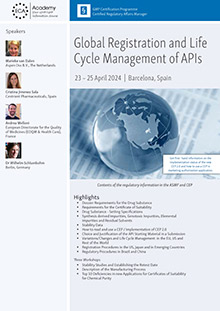FDA releases new internal policy on ICH Q8, Q9, Q10 Guidelines

Recommendation
23-25 April 2024
Barcelona, Spain
On May 18, 2016, the US Food and Drug Administration (FDA) released a new policy document (MAPP 5016.1) to clarify how agency staff in the Office of Pharmaceutical Quality (OPQ) should apply ICH Q8, Q9 and Q10 guidelines.
The new policy outlines the responsibilities and procedures FDA expects its staff to adhere to when applying the ICH guidelines:
Q8(R2): Pharmaceutical Development, Q9: Quality Risk Management and Q10: Pharmaceutical Quality System.
According to FDA, the new policy follows an observed increase in the number of new and supplemental applications for drugs and biologics featuring Quality by Design (QbD) approaches, which are outlined in ICH Q8(R2).
Therefore, "Reviewers should ensure that applications contain at least the minimum information on pharmaceutical development described by ICH Q8(R2) as at a minimum, those aspects of drug substances, excipients, container closure systems and manufacturing processes that are critical to product quality should be determined and control strategies justified," the policy states.
Reviewers should check applications to ensure that certain minimal elements described in the Annex of ICH Q8(R2) are included in all applications, namely:
- Quality target product profile (QTPP),
- Critical quality attributes (CQAs) of the drug product,
- CQAs of the drug substance and excipients,
- Selection of an appropriate manufacturing process,
- Control strategy.
However, analytical methods are not explicitly mentioned in the document and the introduction of, for example, the Analytical Target profile (ATP) -equivalent to the QTPP- has not yet been established.
Additionally, FDA says its reviewers should be making sure the applications demonstrate that the manufacturer has enhanced knowledge of the development and manufacturing processes they have identified in their applications. If necessary, quality reviewers should "confer with CMC (chemistry, manufacturing and controls) subject matter experts and members of the extended review team (e.g., medical officer, pharmacology/toxicology reviewer) to establish the relevance of CMC information that supports the drug's safety, efficacy, and performance.
Additionally more flexible regulatory approaches can be proposed in applications. As described in ICH Q8(R2), manufacturers can justify the use of flexible regulatory approaches in areas where the demonstration of greater understanding of pharmaceutical and manufacturing sciences can create a basis for flexible regulatory approaches. When an application includes information supporting a flexible regulatory approach, the reviewers should determine whether the application "includes sufficient enhanced knowledge that demonstrates the applicant's understanding of material attributes, manufacturing processes, and controls for product quality to support the proposed flexible regulatory approaches."
FDA gives the following examples of potential flexible regulatory approaches a manufacturer can take:
- Manufacturing process improvements without regulatory notification (e.g., movement within a design space),
- Approaches to reduce post-approval submissions through submission of change protocols ("Comparability Protocols"),
- In-process tests in lieu of end product testing, including real time release testing approaches (PAT, RTRT),
- Mathematical models (e.g., multivariate models) as surrogates for traditional end product testing.
Comparability Protocols together with "established conditions" may be effective tools for the overall product life cycle management. They can also facilitate the management of post-approval CMC changes in a more predictable and efficient manner, as it is the intention of the planned ICH Q12 Guideline "Lifecycle Management". Steps 1 and 2 a/b of ICH Q12 are expected for June 2017.
Risk assessments according to ICH Q9 "are usually the basis for the control strategy and those submitted in the application can justify the proposed flexible regulatory approaches." However, in order to determine whether a flexible regulatory approach is appropriate, the reviewers should evaluate the risk assessments provided by the manufacturer to support the use of a flexible approach in a "scientific and risk-based" manner.
Since the manufacturer´s quality system is an important part of ensuring continued product quality (ICH Q10), reviewers should "collaborate with the investigator and compliance officer, as needed, regarding potential risks in the manufacturing process if potential risks are discovered during the course of the review."
For further information please see the Manual of Policies and Procedures on Applying ICH Q8(R2), Q9, and Q10 Principles to Chemistry, Manufacturing, and Controls Review.
Related GMP News
GMP Conferences by Topics
- General Quality Assurance and GMP Compliance Topics
- Hygiene
- General Microbiology Topics
- Regulatory Affairs
- Development
- General Analytics Topics
- Good Distribution Practice
- Sterile Manufacturing
- Computer Validation
- General Qualification/Validation Topics
- General Engineering Topics
- APIs/Excipients
- GMP Basic Training Courses
- Medical Devices and Combination Products
- Packaging and Packaging Material
- Data Integrity
- Qualified Person (QP)
- GMP Auditing
- Documentation
- Cleaning Validation
- General IT Compliance Topics
- Impurities
- OOS / OOE / OOT
- Material Testing
- Validation of Analytical Methods
- Analytical Instrument Qualification
- Stability Testing
- Microbiological Testing
- Technology
- General Manufacturing Topics
- Solid Dosage Forms/Semi-Solid Dosage Forms
- Biotechnology/Blood/ATMP
- Herbal Drug Products/Cannabis/Radiopharmaceuticals
- Others




